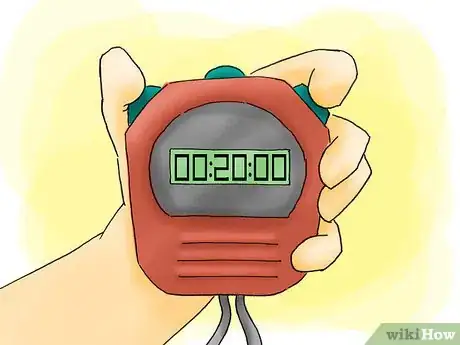This article was co-authored by wikiHow Staff. Our trained team of editors and researchers validate articles for accuracy and comprehensiveness. wikiHow's Content Management Team carefully monitors the work from our editorial staff to ensure that each article is backed by trusted research and meets our high quality standards.
This article has been viewed 192,880 times.
Learn more...
No matter how in shape you think you are, running a 5K can still be a trying experience. If you're determined to run a 5k in 20 minutes, here are some steps that will help you perform your best on race day.
Steps
Training
-
1Train extensively weeks before the race. By developing a training regimen you'll be able to improve your time drastically. Try doing the following exercises to train for a 5K:[1]
- Run up hills. Be sure to be perpendicular to the hill and lift your knees, using the proper healthy running form.
- Run intervals. Run the mile four times, an 800 six times, a 600 eight times, or a 400 ten times. Vary these. Miles should be close to race pace with 3-5 minutes rest intervals. The 600s and 800s work best at 5 seconds per 400 faster than race pace and 2-3 minutes rest interval. 400s in 86-92 would develop adequate speed. Rest 1:30 between each 400
- Practice speeding up when you run. Run a comfortable pace then speed up for about 50 to 100 meters then slow down again. Repeat.
- Run hard courses. Most people do not run very fast when practicing so it is best to run hard courses to still speed up.
-
2Take time to recover. Don't overtrain. Remember it takes your body 3-4 days to recover from a reps session. Ideally do this on a Monday or Tuesday and race on a Saturday.[2]Advertisement
-
3Keep track of your training times. Running 5K in less than 20 minutes requires running at 6:26 pace for 3.1 miles (5.0 km). You need to be able to run at least a 6:00 mile before you run this 5k under 20 minutes. This alone still won't guarantee you your goal time. You must train regularly.
-
4Rest before the big race. Do not do push ups, pull ups or any other strenuous activities. Just stretch and spend time relaxing.[3]
- Eat pasta for dinner. Muscles receive energy from glucose which is found in pasta.
- Go to bed early and make sure you get enough good quality rest before your big race.
- Wake up early. Save yourself enough time to eat a good, but light breakfast at least an hour before the race.
Running the Race
-
1Warm up. If it is cold on race day, keep your muscles warm by stretching.[4] Do some quick sprints up to 100m right before the race.
- Do dynamic stretching beforehand, not static. Dynamic is more moving (i.e. Lunges) and static is more still (i.e. Touching your toes).
-
2Start fast but not too fast. You don't want to run out of gas early. Try to find someone your pace and settle yourself near the front at the start. Pick an athlete just in front of you who looks experienced - grey haired vets are ideal - imagine a rope between the two of you and that rope shortening until you are on their shoulder.
-
3Check your time. If there are mile markers you might want to keep track of your time along the way. If you realize that you are running too slow then you can speed up.[5]
- Your first mile should be about 6:25, but preferably faster.
- Get your second mile split. It should be under 13:00.
-
4Finish strong by sprinting at the end. Empty the rest of what's in your tank and give it all you've got. Check your time and celebrate.
Community Q&A
-
QuestionWhat should I eat and drink after running for good health?
 Community AnswerPasta is helpful, as it will help restore your energy. Also, drink plenty of water throughout the week, not just before the run. Lastly, remember to practice, but don't overwork yourself.
Community AnswerPasta is helpful, as it will help restore your energy. Also, drink plenty of water throughout the week, not just before the run. Lastly, remember to practice, but don't overwork yourself. -
QuestionWhat should I eat before running a race?
 Community AnswerEat something light on your stomach like a protein bar and banana, about one hour before before you run.
Community AnswerEat something light on your stomach like a protein bar and banana, about one hour before before you run. -
QuestionWhat is a good schedule for a 5 km race?
 Community AnswerEvery other day, alternate a regular run and a more intense workout, giving yourself a day in between to rest.
Community AnswerEvery other day, alternate a regular run and a more intense workout, giving yourself a day in between to rest.
Warnings
- Running on concrete (and asphalt to a lesser extent) can be hard on your joints , if something hurts stop running and see a doctor.⧼thumbs_response⧽
- Running on roads can be very dangerous; always watch for cars. Run on the left side of the road (or the right, in countries where cars drive on the left), against traffic unless conditions are prohibitive. It is easier to see a car coming ahead than it is to hear it from behind. (Remember - it's never the car you hear that hits you - it's the car behind it.)⧼thumbs_response⧽
- Do not push yourself too hard, it is dangerous. It should hurt but not too much.⧼thumbs_response⧽
References
About This Article
If you want to run a 5K in 20 minutes, you’ll need to develop a training regimen weeks before the race to help improve your time. As you train, practice speeding up for intervals during your run. For example, go at a comfortable pace for the beginning of your run, then speed up for about 50 to 100 meters before slowing down and repeating the process throughout the session. Additionally, practice on harder courses so when it’s time to run the 5K, it will be easier to speed up. Rest is important, so don’t forget to schedule 3 to 4 days of recovery before your race. Before the race, get plenty of sleep and eat a light breakfast about an hour beforehand. For more tips, like how to warm up before the race, read on.











-Step-17-Version-2.webp)















-Step-17-Version-2.webp)



































